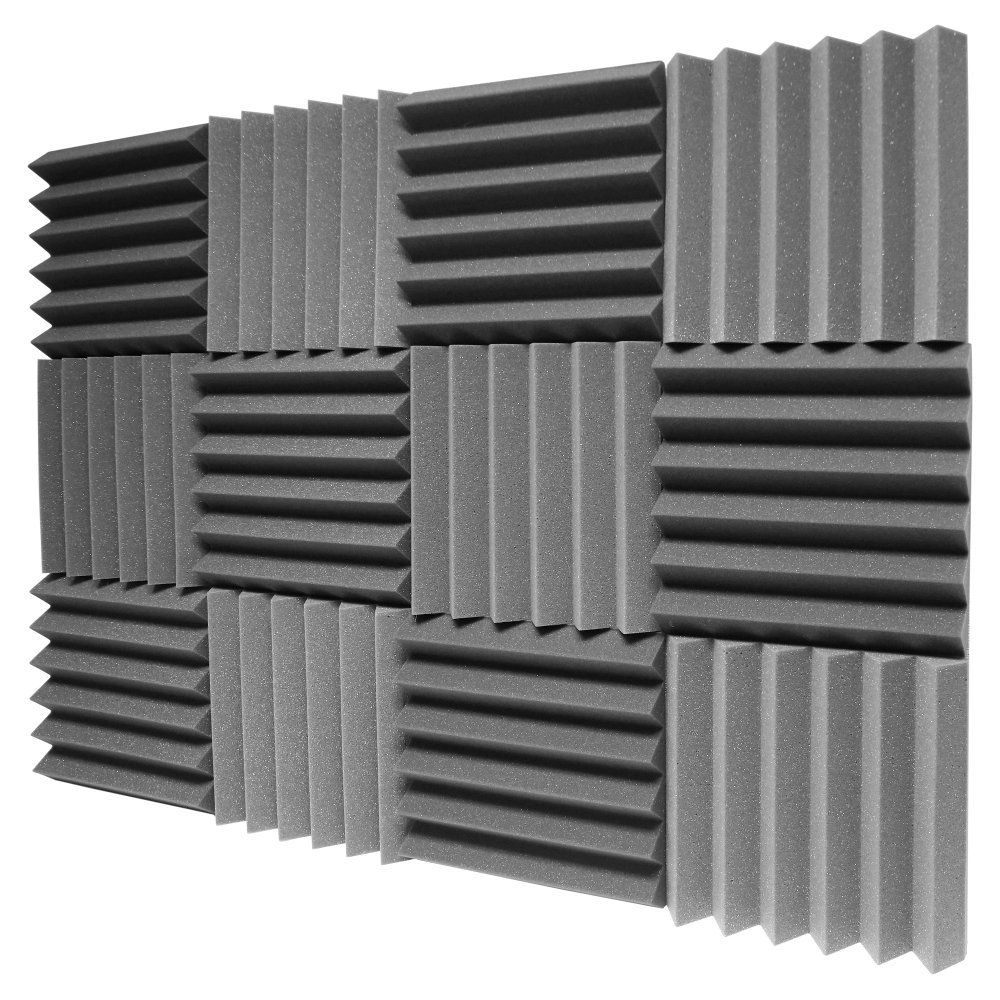Physics of Sound Dampeners and Active Noise Cancellation
Acoustic treatment of soundscapes has grown alongside the sound production industry. Whether through absorption panels, diffusors and cloud panels to treat a space or headphones placed directly over the ears of listeners, acoustic treatment comes in many forms. Environments are treated acoustically to absorb excess sound to prevent sound levels from crossing a threshold above which the desired goal cannot be had. Before getting into sound dampening, we must discuss sound.
Sound is produced when an object vibrates (a form of oscillation) and temporarily displaces nearby air molecules causing a wave effect as the displaced molecules collide with their neighboring molecules. Sound waves are fluctuations in pressure as the initial displacement of molecules experiences collisions that in turn collide with other molecules. The visual below demonstrates this idea well.

Sound dampening foam panels in a recording studio.
ANC headphones worn by pilots and/or passengers in consumer aviation aircraft.
Sound is produced when an object vibrates (a form of oscillation) and temporarily displaces nearby air molecules causing a wave effect as the displaced molecules collide with their neighboring molecules. Sound waves are fluctuations in pressure as the initial displacement of molecules experiences collisions that in turn collide with other molecules. The visual below demonstrates this idea well.
These regular displacements of air can be measured as an oscillation of pressure at a given point. If we call the point 10cm from the vibrating driver that is producing the sound point Q, then we can graph pressure over time at point Q and get a wave form.
Sound waves can travel quite far through a medium like air within a given range of frequencies. Often, lower frequencies carry farther. The human range of hearing begins at approximately 20 Hz and goes up to 20 kHz (20,000 Hz). This range, like the visible spectrum of light, is perceptible by humans. (Now, to return to noise cancellation and acoustic treatment.)
The goal of noise cancellation is to reach a point at which there is little to no sound. Because sound is a pressure wave, we can define this lack of sound as an equilibrium. To reach an equilibrium, the total amount of energy in a system must equal zero.
At each point a given distance from the oscillating source of the sound wave, there are regular fluctuations in pressure. If these fluctuations in pressure are to be counteracted to reach equilibrium, they must be constructed as follows: when there is low pressure, there must be counteracting high pressure, when there is high pressure, there must be counteracting low pressure. These counteracting pressures must have the same period and amplitude as the wave they are intended to cancel. The way that noise cancelling devices accomplish their feat of noise cancellation to determine the period and amplitude of an oscillation and to play that same sound but half a period later.
equation for a sine wave graphed with a cosine wave
The result is that the two sound waves overlap and form the above shape. The above result is called a standing wave.
Standing wave
- a vibration of a system in which some particular points remain fixed while others between them vibrate with the maximum amplitude.
The result is a perceived absence of sound to the listener, the sound has been effectively "cancelled."
Active noise cancellation, or ANC, uses this same principle but is active as it constantly "listens" with a microphone and attempts to cancel sound reactively. This works well for sounds like the drone of a jet engine but does not work well for irregular sounds like a conversation.
The strategy of cancelling sounds works well when the listener is wearing headphones but cannot be used for larger sound spaces where there are sounds that need to be heard like instruments being recorded or voices in conversation. Sound dampening materials and other products are used in these scenarios for acoustic treatment function to absorb sound rather than cancel it. This allows a maximum threshold to be maintained and for sound, especially echoes off of hard surfaces, to be muted.
These "cloud panels," made of glass wool, are used in places like restaurants to absorb sound and dampen echoes.
In studio settings, sound dampening panels cover the walls and ceiling to assist in the isolation of sound for recording without unwanted ambient sound or echoes.
Sound absorbing surfaces, rather than creating a standing wave, serve as a surface with which the displaced air particles carrying the sound wave can have an inelastic collision. The particles enter the sound foam and are absorbed.
In many spaces, hard surfaces are avoided for the sake of sound dampening. In spaces like restaurants and cafes, sound panels are often added to ceilings to help negate the effects of mostly hard surfaces.
Hard surfaces are not always a bad thing in sound, they can also be used to shape a soundscape by deflecting sounds produced by performers towards an audience more effectively.
These methods of dealing with excessive sound to tune environments for desirable effects have spawned an industry of sound engineers that work with spaces to construct an appropriate installation. This cannot be accomplished without an understanding of the physics behind the pressure waves we call sound.
PS such an understanding and a free 5 on the AP exam can be gained by watching 5min of rick and morty it has been scientifically proven





Comments
Post a Comment